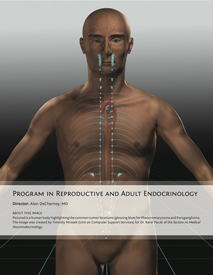You are here: Home > Program in Reproductive and Adult Endocrinology
Program in Reproductive and Adult Endocrinology
Director: Alan DeCherney, MD
The Program on Reproductive and Adult Endocrinology (PRAE) can point to a broad, comprehensive, and exceptional list of publications and activities in the areas of endometriosis, fibroids, infertility, and endocrine aspects of disease—both basic and clinical. The Program has earned recognition as a national leader in the field; in fact, 10 percent of the papers accepted for presentation at a recent annual meeting of the American Society for Reproductive Medicine came from the PRAE. A research project that will be presented at the annual meeting of the Society for Gynecologic Investigation includes developing a method of cellular therapy to treat endometrial diseases. Bone marrow–derived cells engraft in the uterus; however, it is unknown which specific cell type is responsible for this engraftment. If the cellular subpopulation could be identified, this could be a way to introduce healthy cells into the uterus to treat scarring of the uterine cavity (Asherman's syndrome), recurrent miscarriage, abnormal uterine bleeding, or endometriosis. The primary goal is to develop and characterize the first model system to study endometrial engraftment, using a chimeric bone marrow model in both humans and non-human primates. The project has resulted in a successful Phase II application for the Reproductive Scientist Development program, and it also complements our clinical research projects. Newer (less toxic) methods of Peripheral Blood Stem Cell Transplant (PBSCT) have resulted in an expanding list of indications to treat nonmalignant conditions; however, their impact on fertility is not known. In collaboration with the hematology branch of NHLBI, we are characterizing fertility in patients undergoing PBSCT.
The Section on Implantation and Oocyte Physiology, led by Alan DeCherney, has been working on the regulation of blasotcyst development using the in vitro fertilization (IVF) approach with both mouse and primate animal models. The Section is investigating pre- and peri-implanation embryos' signaling pathways that regulate oxygen levels, growth factors, and extracellular matrix. Work also continues on a non-invasive method to obtain fetal cells that migrate into the cervical canal during the first trimester, which will make it easier to distinguish a blighted embryo from normal pregnancy and ectopic pregnancies. This single-cell investigation will permit earlier and more sophisticated prenatal diagnosis than is currently available.
The Section on Reproductive Medicine, headed by Lynnette Nieman, works on the hypothalamic pituitary adrenal axis in pregnancy, which complicates differential diagnosis of Cushing's syndrome, and on assessing the relative merits of immunometric and radioimmunoassay measurement of ACTH for diagnosis. The Section continues its work on the diagnosis and management of patients with hypercortisolism, recently focusing on ectopic ACTH-secreting tumors and their localization. Another focus of the Section's work is endometrial physiology and endometriosis pathologies, publishing studies on the endometrium, describing the localization of lesions in women with endometriosis, and use of raloxifene as an adjunct treatment for endometriosis. The Section found that staining of CD10, a cell-surface metalloendopeptidase present in normal endometrium, is helpful in diagnosing endometriosis.
The Section on Medical Neuroendocrinology, under the direction of Karel Pacak, continues to focus on neuroendocrine disorders, particularly pheochromocytoma. The Section used micro-computed tomography for early diagnosis of ectopic pheochromocytoma tumor in the liver of the nude mouse, a technique that may be applied to the human and that would be an excellent way to diagnose early small metastases. In addition, members of the Section noted that mutations of the SDHB gene are associated with one-half of all malignancies originating from extra-adrenal paragangliomas. The high frequency of SDHB germline mutations among patients with malignant disease, particularly when originating from adrenal paraganglioma, may justify giving high priority to SDHB germline mutation testing in such patients.
James Segars, who heads the Unit on Reproductive Endocrinology and Infertility, and his colleagues addressed disparities in access to reproductive services and treatment. Collaborative work established a complex relationship between the BRX gene complex and fibroid generation, and the Unit is expanding its work on several aspects of fibroids, including gene regulation and growth factors. With regard to fertility, the Walter Reed Army Medical Center's Assisted Reproductive Technologies Program continues to provide material for clinical studies. The Oocyte Physician Program, involving investigators at the NIH and the laboratory of Jacques Cohen in Livingston, New Jersey, looked at the effect of leiomyomas on early pregnancy, anti-Müllerin hormone pre- and post-myomectomy, and ovarian reserves in patients with fibroids. A new area of investigation has been the assessment and preservation of ovarian function in women and girls undergoing cancer treatment. Another area of investigation is to assess whether obesity causes abnormal endometrial development. Several studies correlate endometrial thickness with pregnancy success; however, no study demonstrates a relationship between BMI, circulating E2 levels, and endometrial thickness. The Unit is thus examining the influence of BMI on endometrial development and E2 levels during ovarian stimulation with an IUI.



